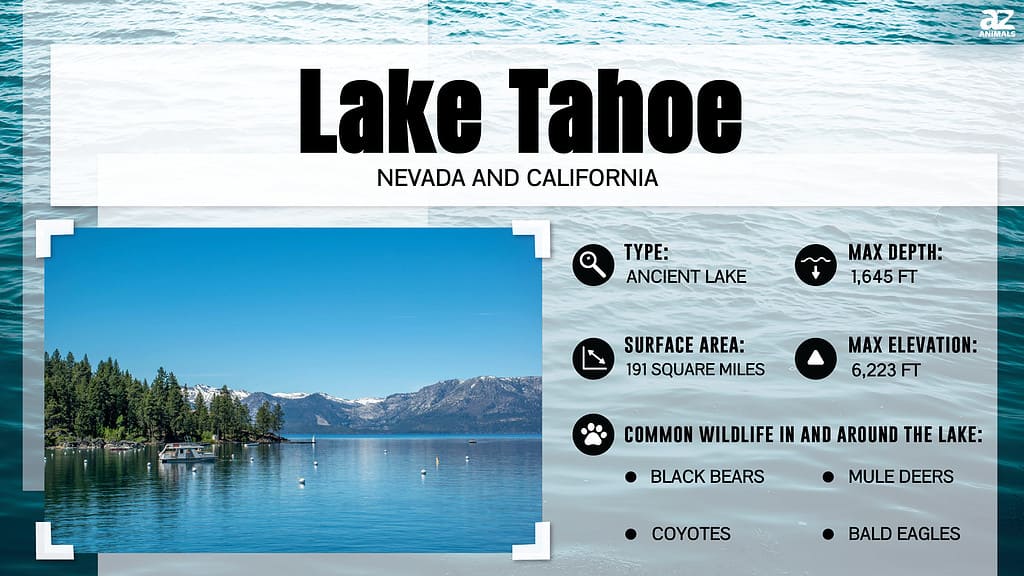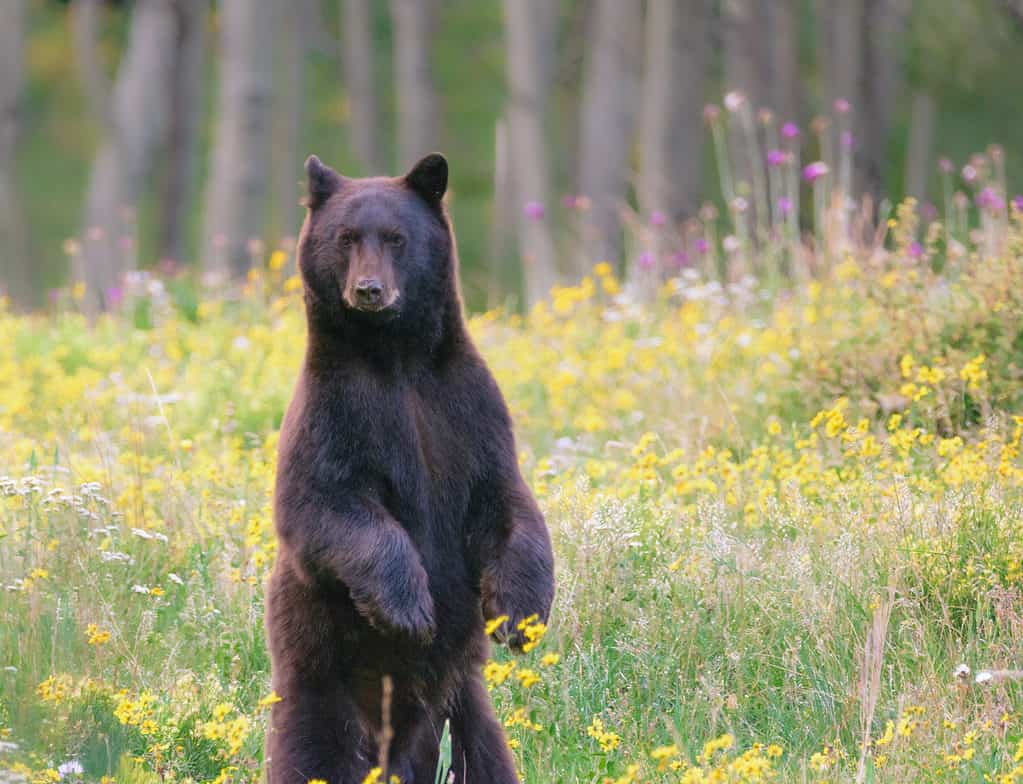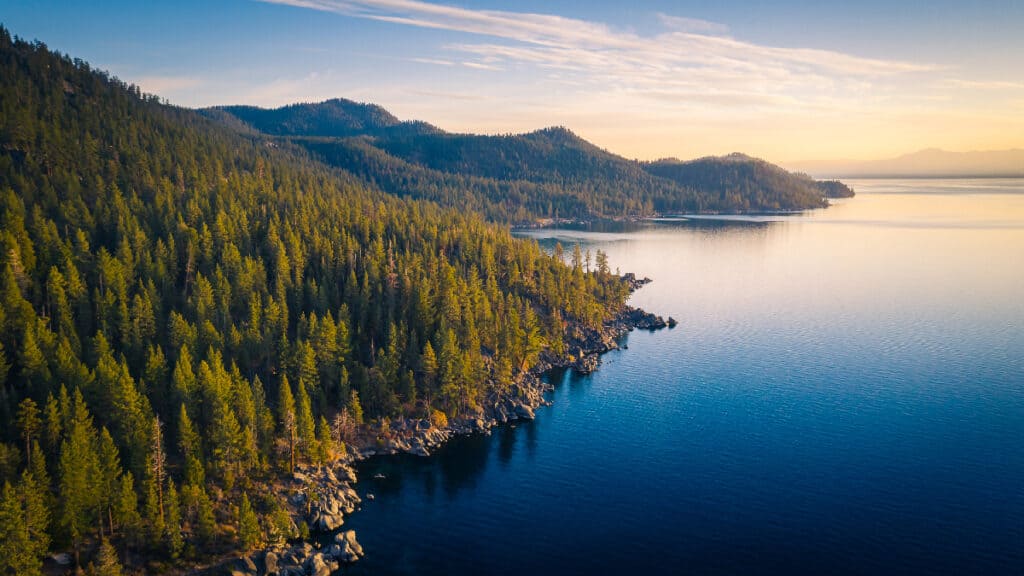Lake Tahoe is one of the most beautiful lakes to visit in the United States. Tourists flock to the region every year to soak up the sun and natural scenery. The area also features incredible wildlife that is sure to stun visitors of Lake Tahoe.

Part of visiting Lake Tahoe, though, includes adjusting properly to its elevation. The lake sits at a higher elevation than most other lakes in the United States, meaning that proper care of the body is important in maintaining healthy oxygen levels. Find out Lake Tahoe’s elevation and how to acclimate to Tahoe’s environment.
Background on Lake Tahoe
Lake Tahoe is a large freshwater lake that sits between the states of California and Nevada. The lake has a surface area of 193 square miles, and it is 1,640 feet deep at its deepest point. Lake Tahoe depths have a greater measurement than that of the Empire State Building’s height, which stands at 1,454 feet tall. The name “Tahoe” derives from the Washoe Native American term for “big water.” The lake was formed by fluctuation in the landscape from faulting in tectonic plate boundaries.
Lake Tahoe is up to two million years old, making it one of the top 20 oldest lakes on Earth. It also ranks #6 in the largest takes by volume in the nation. The volume of Lake Tahoe measures 39 trillion gallons. Furthermore, 1.4 million gallons of water evaporate from the lake every day. Considering its volume, the evaporation rate barely makes a dent in Tahoe’s massive size.

At up to two million years old, Lake Tahoe is one of the oldest lakes on Earth.
©Madhu Gopal/Shutterstock.com
Lake Tahoe flows into the Truckee River, which is Tahoe’s only outlet. While 63 streams pour water into the lake, only the Truckee River receives water directly from Lake Tahoe.
Water in Lake Tahoe derives from precipitation in the forms of rain and snowfall, which are mainly deposited into the lake by the 63 streams. The streams and precipitation on the surface of the lake deposit around 212 billion gallons of water.
Something impressive about the lake is that its waters are extremely pure. Water in Lake Tahoe is 99.994% pure. Its purity makes the lake popular for the tap water that it produces. In fact, its drinking water has been determined to be the best tasting in the United States. The water is also extremely cold. Deeper regions of the lake consistently remain at 39ºF. On the other hand, surface temperatures range from 40ºF during winter to 65ºF during summer.
Climate and Weather in Lake Tahoe

Lake Tahoe is a consistently sunny location.
©iStock.com/CelsoDiniz
Climate and weather on and near Lake Tahoe fluctuate greatly according to changes in season. However, one consistent aspect of the weather in Lake Tahoe is sunshine. The lake sees over 300 sunny days annually, even during the winter months. Lake Tahoe’s climate is temperate and usually dry. Therefore, humidity is almost never a concern for visitors that chose to travel to Lake Tahoe.
The hottest month in Lake Tahoe is July with average temperature highs around 74ºF. On the other hand, January is the coldest month with average temperature highs of 40ºF. Lake Tahoe also receives snow during winter, especially during the month of January. During January, over 68 inches of snow can accumulate in and around the Lake Tahoe region.
The seasons of spring and fall also see an abundance of snowfall. The month of March averages 74 inches of snowfall. As winter fades away and spring begins, the amount of snowfall decreases. Although, visitors will still experience over 10 inches of snowfall into the month of May. During fall, snow typically begins to come down during October, which averages 30 inches.
Due to Tahoe’s climate variability, the region offers plenty of activities for visitors year-round. Biking, boating, and sunbathing in Lake Tahoe are activities to consider during the summer. By contrast, hiking, snowshoeing, snowmobiling, and ice skating are available to winter visitors. Skiing in lake Tahoe is also popular, as the destination features an assortment of cross-country and downhill skiing opportunities that rival those of other prominent ski resorts across the country.
Wildlife Around Lake Tahoe

If you’re around Lake Tahoe, avoid leaving out food that may attract bears.
©Constance Mahoney/Shutterstock.com
Wildlife in and around Lake Tahoe includes a diverse assortment of mammals, birds, fish, and more. Black bears live in the bordering Sierra Nevada mountains. While these creatures are stunning, they can be dangerous. People traveling to the Lake Tahoe region should be careful to avoid leaving out food that might attract black bears. Furthermore, visitors of Lake Tahoe should leave black bears alone if they stumble across one. Human interaction with black bears can result in negative effects on the bears’ environments and habitats.
Other mammals in Lake Tahoe include squirrels, raccoons, mule deer, and coyotes. Coyotes can be aggressive animals, though. To avoid a fateful encounter with a coyote, pets brought to Lake Tahoe by tourists should be kept on a leash. Birds soaring in Lake Tahoe skies include the mountain chickadee, bald eagles, ospreys, and waterfowl like mallards. One unique bird species, the steller’s jay, is prone to stealing food left out by humans. Steller’s jays are a beautiful species whose feathers have a black and striking blue coloration.
Several fishing opportunities and fish species also exist in the lake. Crappies, small catfish, and many species of trout and bass swim in Lake Tahoe waters. The mackinaw trout is the most prevalent fish in the lake and the most popular fish to catch. Mackinaw trout can be found in waters with cold temperatures under 52ºF. These fish weigh between five and 20 pounds, and the best time to catch them is between the months of March and June.
Another popular catch is the kokanee. The best time to catch kokanee occurs between July and October. Unlike the mackinaw trout, kokanee can be encountered in warm, deep waters. Therefore, boat fishing will likely produce more successful results for those searching for kokanee than fishing from the shoreline will.
What Is the Elevation of Lake Tahoe?

Lake Tahoe is 6,223 feet above sea level.
©iStock.com/heyengel
The elevation of Lake Tahoe is 6,223 feet above sea level. The lake’s high elevation is a primary reason why it receives an abundance of snowfall during winter. Being over 6,000 feet above sea level, Lake Tahoe falls into the “high lake” category. It is also the largest alpine lake on the continent. When traveling to Lake Tahoe, especially during winter, tourists should take steps to acclimate to the elevation change, as less oxygen is available at higher elevations. A few ways to acclimate to Lake Tahoe’s high elevation are listed below:
- Be sure to spend a day or so relaxing upon arrival at Lake Tahoe. Resting the body is key to acclimating to elevation change before engaging in more strenuous activities.
- Eat regularly. The body will be working overtime as it takes in less oxygen. Overwork by the body to take in a lower percentage of oxygen in the atmosphere burns calories, so maintaining a good diet is crucial.
- Avoid consuming alcohol. Alcohol can dehydrate the body and interfere with sleep and relaxation.
- Drink plenty of water. The body will need more water as it adapts to taking in less oxygen from the atmosphere.
After taking time to relax upon arrival, a visitor can begin to explore the beautiful Lake Tahoe. Starting off slow is the best way to adapt. For those that enjoy hiking, beginning with short and flat hikes are key to adjusting to lower oxygen levels. Jumping right into a long, uphill hike is not advised because elevation will increase along these hikes, making oxygen less available than it is at Lake Tahoe’s elevation.
While the entirety of Lake Tahoe experiences 20% less oxygen than at sea level, the summit of Monument Peak, which sits near the lake, sees 36.6% less oxygen than at sea level. Therefore, climbing to the summit on the first day of a trip to Lake Tahoe is not a way to adapt nor a way to care of the body.
The photo featured at the top of this post is © topseller/Shutterstock.com
Sources
- Britannica, Available here: https://www.britannica.com/place/Lake-Tahoe
- United States Department of Agriculture, Available here: https://www.fs.usda.gov/detail/ltbmu/learning/?cid=stelprdb5109570
- North Lake Tahoe, Available here: https://www.gotahoenorth.com/lake-tahoe-activities/?gclid=CjwKCAiA2rOeBhAsEiwA2Pl7Q18zoUbLda0LYPNmmSueUhqPnleGlFddLZL6DbLjA6iOVAEhXgaxoRoC7RwQAvD_BwE
- Suzie Dundas, Available here: https://www.tripsavvy.com/lake-tahoe-weather-and-climate-1478030
- Trent Unruh, Available here: https://visitlaketahoe.com/blog/wildlife-of-the-lake-tahoe-basin/
- Andriana, Available here: https://fishingbooker.com/blog/lake-tahoe-fishing/
- Gabriel Glasier, Available here: https://cheftravelguide.com/lake-tahoe-altitude/
- Gabriel Glasier, Available here: https://cheftravelguide.com/fun-facts-about-lake-tahoe/
FAQs (Frequently Asked Questions)
What is the elevation of Lake Tahoe?
The elevation of Lake Tahoe is 6,223 feet above sea level.
What are some ways to adjust to the elevation change upon arrival at Lake Tahoe?
Rest and relaxation, hydration, a healthy diet, and a decrease in alcohol consumption can help a visitor adjust to Lake Tahoe’s elevation.
What kind of wildlife live in Lake Tahoe?
Black bears, raccoons, mackinaw trout, coyotes, and various other animal species live in and around Lake Tahoe.
Thank you for reading! Have some feedback for us? Contact the AZ Animals editorial team.






